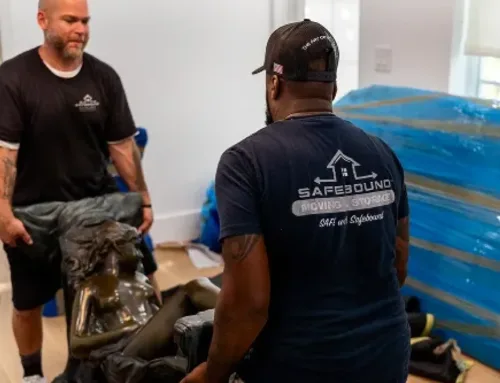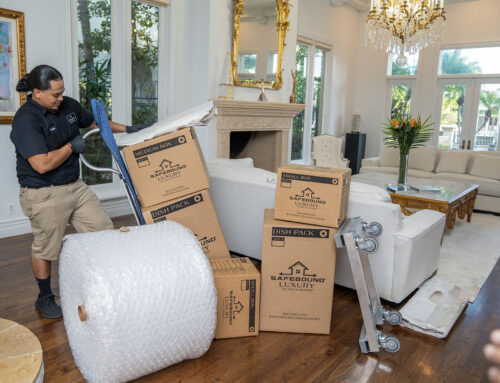How To Move With Your Dog
So you’re planning to move and you need to learn how to move with your dog! If you’ve read any of our other moving guides, you should know that moving day is only a very small part of the moving process. Much more should go into the planning and preparation stages. When you’re moving with pets, the same principles apply. So in those few weeks leading up to your move, there are a few things you should do for your furry friend.
Before Moving Day
First, you should keep their daily routine unchanged. As you begin to pack and the house begins to look different, they’ll probably notice. If your dog knows you well, they’ll know when you’re about to go on vacation or a business trip for a few days. They notice the bags packed and the change in your temperament. A move is a stressful time for you and your family, and that stress rubs off on your pets. The calmer you are, the more relaxed your pets will be.
We also recommend you visit the vet a little before you move. Let the vet know that you’ll be moving soon and listen to the advice your vet gives you. Take their recommendations. They might prescribe your dog anti-anxiety meds to make moving day a bit smoother.
Like we mentioned earlier, you want to remain as calm as possible. When you’re on the phone talking with the moving company or friends and family about the move, your voice might tend to get tense or anxious. Your dog notices. So when you’re talking about the move, you need to try to stay calm.
Your dog will also notice the boxes that start to pile up and the changes in your home as more and more things get packed. They will notice things scattered in different rooms as you sort and organize everything. And they are going to see and smell strangers coming in and out of your home as you prepare for the move. Lots of moving companies conduct an in-person survey to calculate prices, and you might bring in a professional to disconnect your computers, television, and home security systems.
Dogs are creatures of habit, and they notice all of these major changes happening around them. They pick up when things are changing and when things are different. With a move, you’re changing everything. So your dog is going to notice.
Even though dogs can’t necessarily understand our human language, they can understand the energy emanating from your voice. Although it might seem silly, you should talk to your dog and reassure them that everything will be okay, that they are coming with you, and other general reassurances. Basically, give your dog a loving pep talk throughout the days! Use a soothing tone of voice to remind them that it’ll be okay even though things are changing.
Like we mentioned earlier, you should maintain your dog’s routine before, during, and after the move. Though you won’t be able to keep things exactly the same, especially on moving day, you should keep their routine as consistent as possible. For example, feed them at the same time. Take them for walks at the same time. Without their routine, they can quickly get more anxious and stressed.
In the weeks leading up to moving day, it’s a good idea to give your dog more exercise than they’re used to. This provides more routine and an outlet for them to release all of that pent-up nervous energy.
If your dog isn’t already crate trained, moving is an excellent opportunity to implement that practice into your dog’s life. Their crate serves as a safe space during the chaos of a move. When several people are packing and things are moving, they can feel safe and calm in their crate. To crate train your dog, you need to make the cage a positive place. Put their favorite blanket and toys in there. Give your dog lots of treats when they’re in it. The point is to make the cage a safe zone that’s comfortable for them.
Dogs On Moving Day
On moving day, take all of your veterinarian’s recommendations. Keep your dog at a friend’s house or shelter them in their crate in a room that nobody enters. Moving day is the perfect storm for dogs. You’ll have plenty of strangers coming in and out, doors constantly open, heavy objects moving around. It will be controlled chaos. Moving day isn’t the time to test your dog’s obedience.
To get your dog to your new home, you have three options. You can take them in your car, fly with them, or hire pet movers who will take your pup to your new home. We recommend driving, as this is the least stressful option for your dog. They’ll be happy to stay with their familiar owners, and you’ll be able to make plenty of stops to give them some exercise and breaks from the car. Unfortunately, planes and airports are incredibly stressful for dogs, and pet movers can be grossly expensive.
If you have to fly, there are a few steps you can take to ease your anxious pup’s mind. Adaptil collars or sprays can calm nervous dogs because it mimics calming pheromones of the mother. The ThunderShirt is a type of weighted blanket for dogs. It distributes pressure through the dog’s back and sides. Always consult your veterinarian before using any of these devices. If the vet gives you the green light, try the product with your dog several times before moving day.
In The New House
It’ll take time before your dog acclimates to the new environment when you get to the new house. So that crate training will come in handy in this new place. Remember, the whole point of crate training is to create a safe space for your dog.
Maintain that routine we talked about throughout this article. Routine is going to be the key to settling your dog into your new house. Although you’re changing the setting, you should keep the same schedule.
Moving is stressful enough, and moving with a dog adds another layer of things to worry about. You’ll have to remain calm for your dog to stay calm. Stay in close contact with your veterinarian. Maintain those routines that your dog is used to. Consider investing in some of those anti-anxiety tools we mentioned. Take advantage of crate training. And in the new home, remember that time is going to be your best friend. If you keep all of these points in mind, the move with your dog should go smoothly.





